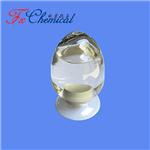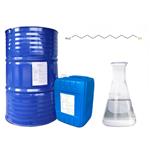- 1-Dodecanethiol
-

- $1.00 / 1KG
-
2025-03-28
- CAS:112-55-0
- Min. Order: 1KG
- Purity: 99%
- Supply Ability: 10 mt
- 1-Dodecanethiol
-

- $0.00 / 25KG
-
2025-03-28
- CAS:112-55-0
- Min. Order: 25KG
- Purity: 98%min
- Supply Ability: 30tons/month
- 1-Dodecanethiol
-

- $0.00 / 200kg
-
2025-03-27
- CAS:112-55-0
- Min. Order: 20kg
- Purity: 98.5%
- Supply Ability: 10 tons
|
| | 1-Dodecanethiol Basic information |
| Product Name: | 1-Dodecanethiol | | Synonyms: | 1-dodecylmercaptan;dodecanethiol(non-specificname);dodecanethiolnormal;laurylmercaptide;m-dodecylmercaptan;m-laurylmercaptan;NCI-C60935;n-Lauryl mercaptan | | CAS: | 112-55-0 | | MF: | C12H26S | | MW: | 202.4 | | EINECS: | 203-984-1 | | Product Categories: | bc0001 | | Mol File: | 112-55-0.mol |  |
| | 1-Dodecanethiol Chemical Properties |
| Melting point | -7 °C | | Boiling point | 266-283 °C(lit.) | | density | 0.845 g/mL at 25 °C(lit.) | | vapor density | 7 (vs air) | | vapor pressure | 0.002 hPa (20 °C) | | refractive index | n20/D 1.459(lit.) | | FEMA | 4581 | DODECANETHIOL | | Fp | >230 °F | | storage temp. | Store below +30°C. | | solubility | Chloroform (Sparingly), Methanol (Slightly) | | pka | 10.49±0.10(Predicted) | | form | Liquid | | color | Clear | | Odor | Stench | | Odor Type | sulfurous | | Water Solubility | IMMISCIBLE | | Sensitive | Air Sensitive | | λmax | 205nm(lit.) | | JECFA Number | 1924 | | BRN | 969337 | | Exposure limits | ACGIH: TWA 0.1 ppm
NIOSH: Ceiling 0.5 ppm(4.1 mg/m3) | | Stability: | Air Sensitive | | InChIKey | WNAHIZMDSQCWRP-UHFFFAOYSA-N | | LogP | 6.18 | | CAS DataBase Reference | 112-55-0(CAS DataBase Reference) | | NIST Chemistry Reference | 1-Dodecanethiol(112-55-0) | | EPA Substance Registry System | Dodecyl mercaptan (112-55-0) |
| | 1-Dodecanethiol Usage And Synthesis |
| Chemical Properties | 1-Dodecanethiol is a colourless liquid organic compound, with a characteristic odour. Soluble in methanol, ether, acetone, benzene, ethyl acetate, insoluble in water. | | Uses | 1-Dodecanethiol can be used for the synthesis of thiol-stabilized metal nanoparticles (NPs), such as gold nanoparticles and silver nanoparticles, which have been produced for use as catalysts, electronic devices, fillers, sensors and active components in composite materials, and other applications.
This molecule is used for the production of hydrophobic SAMs. It can also be used in mixed SAMs to give a hydrophobic background and act as a spacer to move other functional groups or domains farther apart.
Further, it is utilized as a polymerization inhibitor in polyurethane and neoprene adhesives, which finds application in the footwear industry. In addition to this, it acts as a protein regenerating agent used for the regeneration of native proteins from mercuribenzoate. | | Preparation | Preparation of 1-dodecanethiol: 1-Bromododecane, thiourea and 95% ethanol are heated to reflux reaction, then sodium hydroxide solution is added and heated. After the reaction is finished, cooled and left to stratify, the oil layer is the crude thiol. The crude product is washed with water, dried, distilled, and distilled under reduced pressure, which is 1-dodecanethiol. | | Application | 1-Dodecanethiol (DDT) can be used as a source of sulfur for the synthesis CdS quantum dots (QDs) and lead sulfide nanoparticles (PbS) which find potential applications in energy efficient lighting, solar cells and as ammonium gas sensing agents. DDT may be used to form a self-assembled monolayer (SAM) on copper surface as a corrosion resistant coating. Functionalization with DDT may form SAMs on geranium (Ge) to improve the surface characteristics for futuristic applications in microelectronics. This molecule is used for the production of hydrophobic SAMs. It can also be used in mixed SAMs to give a hydrophobic background and act as a spacer to move other functional groups or domains farther apart. | | Description | 1-Dodecanethiol is a kind of oily colorless liquid with a mild skunk odor. It is used in the preparation of hydrophobic or mixed self-assembled monolayers. | | Air & Water Reactions | Air and moisture sensitive. Insoluble in water. Reacts vigorously with water or steam. | | Reactivity Profile | 1-Dodecanethiol is incompatible with bases, oxidizing agents, reducing agents and alkali metals. Easily oxidized to disulfide. | | Health Hazard | 1-Dodecanethiol is irritating to skin, eyes, and mucous membranes. Ingestion may cause nausea. Repeated skin exposure can cause dermatitis and may produce a sensitizing effect. It is very toxic to aquatic life with long lasting effects. | | Fire Hazard | Special Hazards of Combustion Products: Poisonous and irritating gases (e.g., sulfur dioxide) are generated in fires. | | Purification Methods | Dry it with CaO for several days, then distil it from CaO. [Beilstein 1 IV 1851.] | | Toxics Screening Level | The Initial threshold Screening Level (ITSL) is μg/m3 with an 8-hour average. |
| | 1-Dodecanethiol Preparation Products And Raw materials |
|